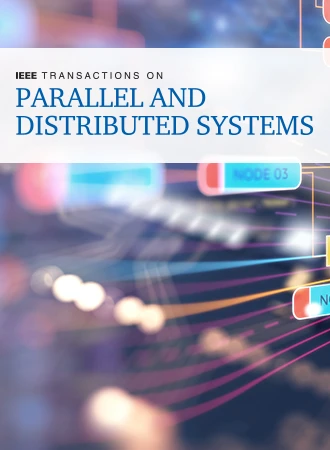WCET Estimation for CNN Inference on FPGA SoC With Multi-DPU Engines
IF 5.6
2区 计算机科学
Q1 COMPUTER SCIENCE, THEORY & METHODS
IEEE Transactions on Parallel and Distributed Systems
Pub Date : 2025-04-01
DOI:10.1109/TPDS.2025.3555968
引用次数: 0
Abstract
The Deep Learning Processor Unit (DPU) released in the official Xilinx Vitis AI toolchain stands as a commercial off-the-shelf solution tailored for accelerating convolutional neural network (CNN) inference on Xilinx FPGA devices. While most FPGA accelerator focus on high performance and energy-efficiency, analyzing the worst-case execution time (WCET) bound is essential for using CNN accelerations in real-time embedded systems design. In this work, we show that in a multi-DPU environment, the observed worst-case inference time for a CNN inference task could become 3X larger w.r.t. the best case inference time, which prompts the prominent importance of a static timing analysis for FPGA-based CNN inference. We propose, to the best of the authors’ knowledge, the first static timing analysis framework for CNN inference in a multi-DPU environment. The proposed framework introduces a generalized timing behavior model for shared bus arbitration and memory access contention between parallel running DPU engines. Additionally, it incorporates a fine-grained memory access contention analysis that takes into account the characteristics of deep learning applications. For a single-DPU environment, the analysis result is 27% tighter in average compared with the state-of-the-art results. Furthermore, our proposed method produces relatively tight estimated results in the multi-DPU environment.基于多cpu引擎的FPGA SoC CNN推理WCET估计
Xilinx Vitis AI官方工具链中发布的深度学习处理器单元(DPU)是为加速Xilinx FPGA设备上的卷积神经网络(CNN)推理而量身定制的商用现成解决方案。虽然大多数FPGA加速器都专注于高性能和节能,但分析最坏情况执行时间(WCET)边界对于在实时嵌入式系统设计中使用CNN加速至关重要。在这项工作中,我们表明,在多dpu环境中,观察到的CNN推理任务的最坏情况推理时间可能比最佳情况推理时间大3倍,这提示了基于fpga的CNN推理的静态时序分析的重要性。据作者所知,我们提出了第一个在多dpu环境下用于CNN推理的静态时序分析框架。该框架引入了一种通用的时序行为模型,用于并行运行的DPU引擎之间的共享总线仲裁和内存访问争用。此外,它还结合了细粒度的内存访问争用分析,该分析考虑了深度学习应用程序的特点。对于单dpu环境,与最先进的结果相比,分析结果平均紧凑27%。此外,我们提出的方法在多dpu环境下产生相对严格的估计结果。
本文章由计算机程序翻译,如有差异,请以英文原文为准。
求助全文
约1分钟内获得全文
求助全文
来源期刊

IEEE Transactions on Parallel and Distributed Systems
工程技术-工程:电子与电气
CiteScore
11.00
自引率
9.40%
发文量
281
审稿时长
5.6 months
期刊介绍:
IEEE Transactions on Parallel and Distributed Systems (TPDS) is published monthly. It publishes a range of papers, comments on previously published papers, and survey articles that deal with the parallel and distributed systems research areas of current importance to our readers. Particular areas of interest include, but are not limited to:
a) Parallel and distributed algorithms, focusing on topics such as: models of computation; numerical, combinatorial, and data-intensive parallel algorithms, scalability of algorithms and data structures for parallel and distributed systems, communication and synchronization protocols, network algorithms, scheduling, and load balancing.
b) Applications of parallel and distributed computing, including computational and data-enabled science and engineering, big data applications, parallel crowd sourcing, large-scale social network analysis, management of big data, cloud and grid computing, scientific and biomedical applications, mobile computing, and cyber-physical systems.
c) Parallel and distributed architectures, including architectures for instruction-level and thread-level parallelism; design, analysis, implementation, fault resilience and performance measurements of multiple-processor systems; multicore processors, heterogeneous many-core systems; petascale and exascale systems designs; novel big data architectures; special purpose architectures, including graphics processors, signal processors, network processors, media accelerators, and other special purpose processors and accelerators; impact of technology on architecture; network and interconnect architectures; parallel I/O and storage systems; architecture of the memory hierarchy; power-efficient and green computing architectures; dependable architectures; and performance modeling and evaluation.
d) Parallel and distributed software, including parallel and multicore programming languages and compilers, runtime systems, operating systems, Internet computing and web services, resource management including green computing, middleware for grids, clouds, and data centers, libraries, performance modeling and evaluation, parallel programming paradigms, and programming environments and tools.
 求助内容:
求助内容: 应助结果提醒方式:
应助结果提醒方式:


